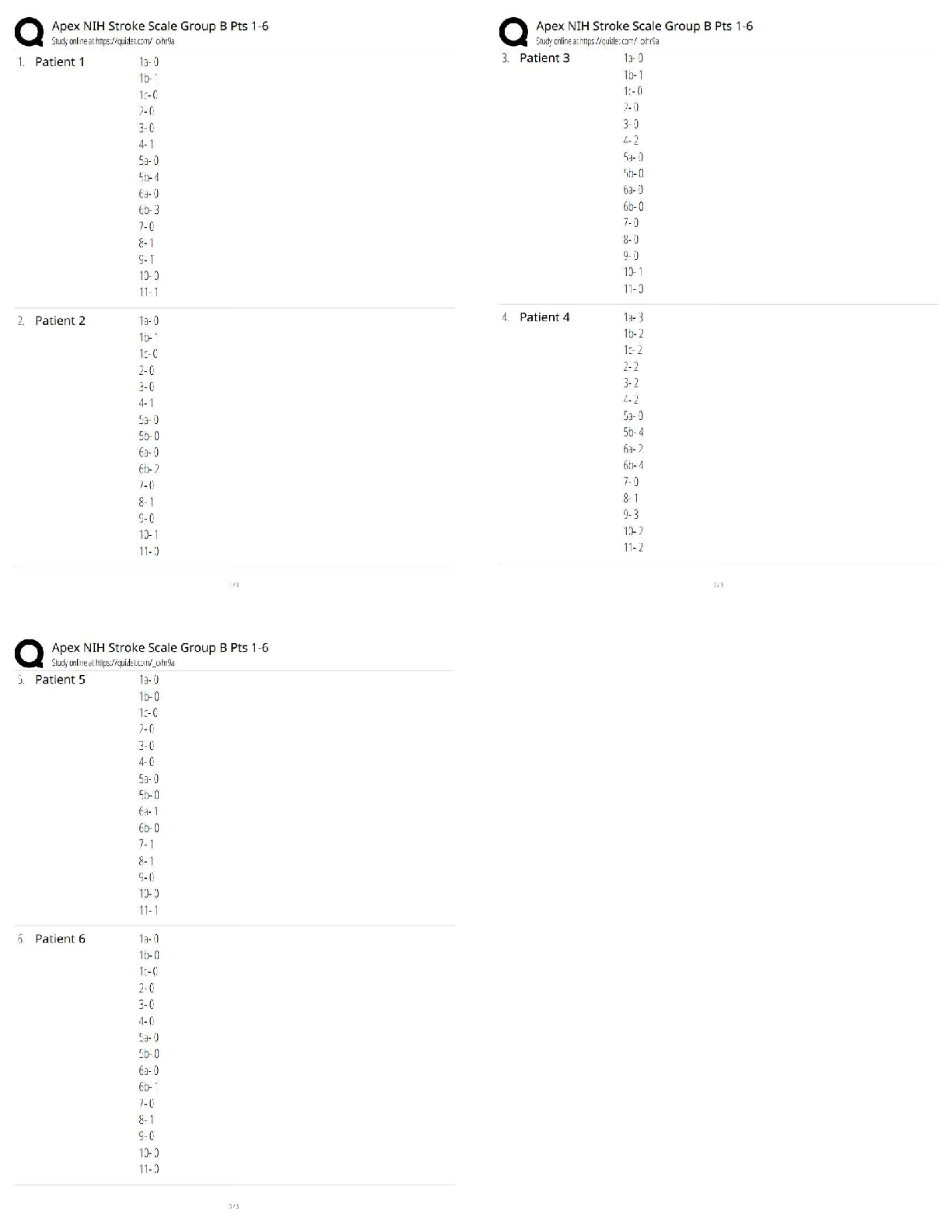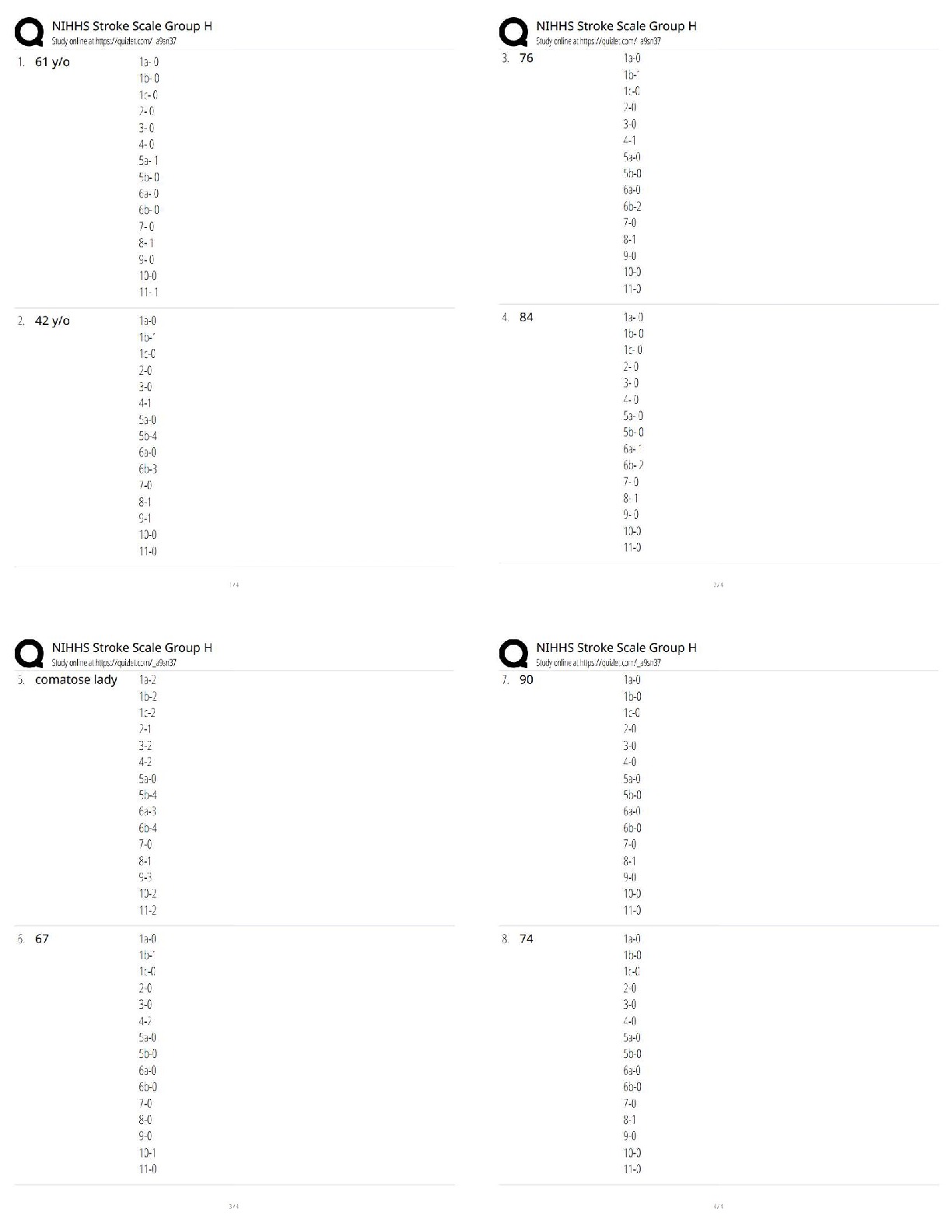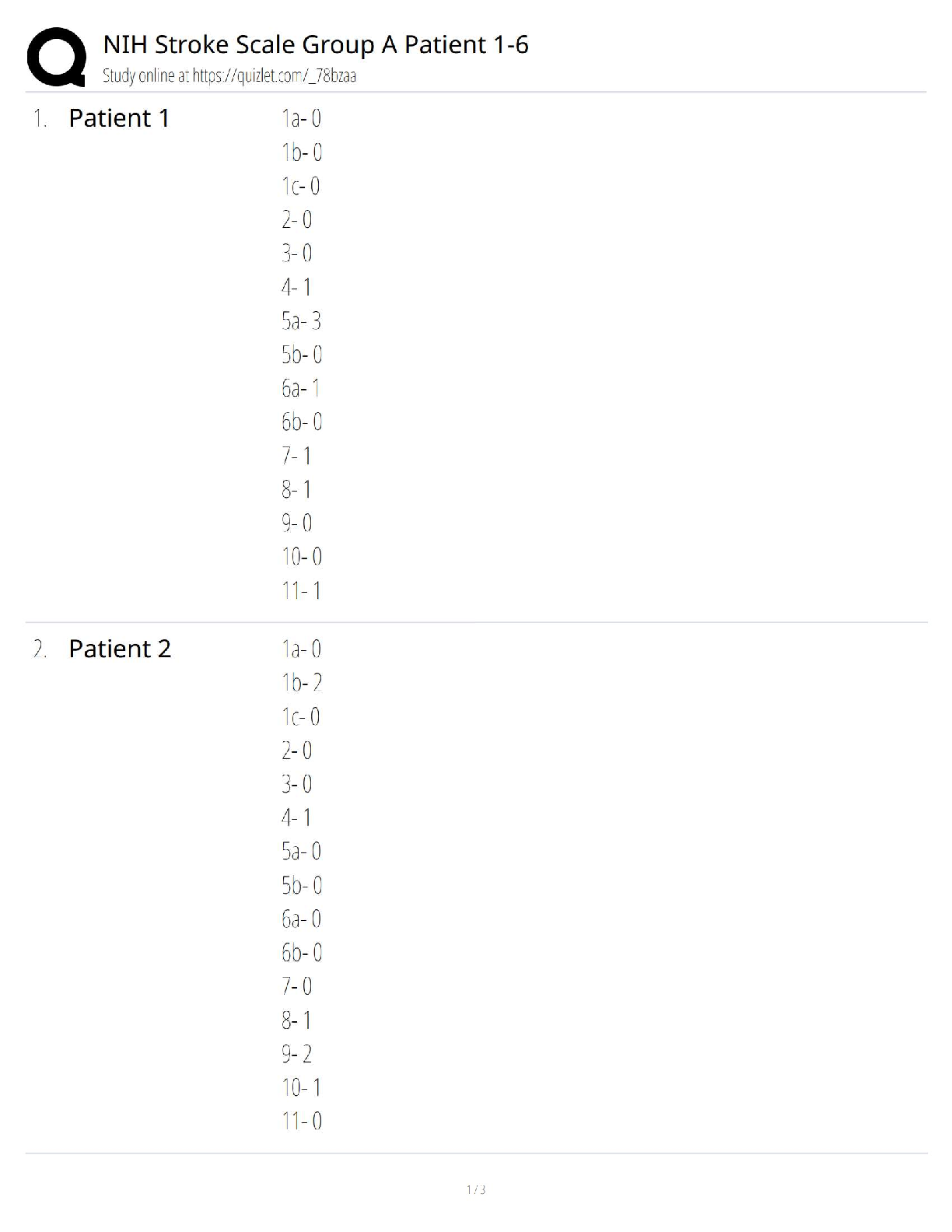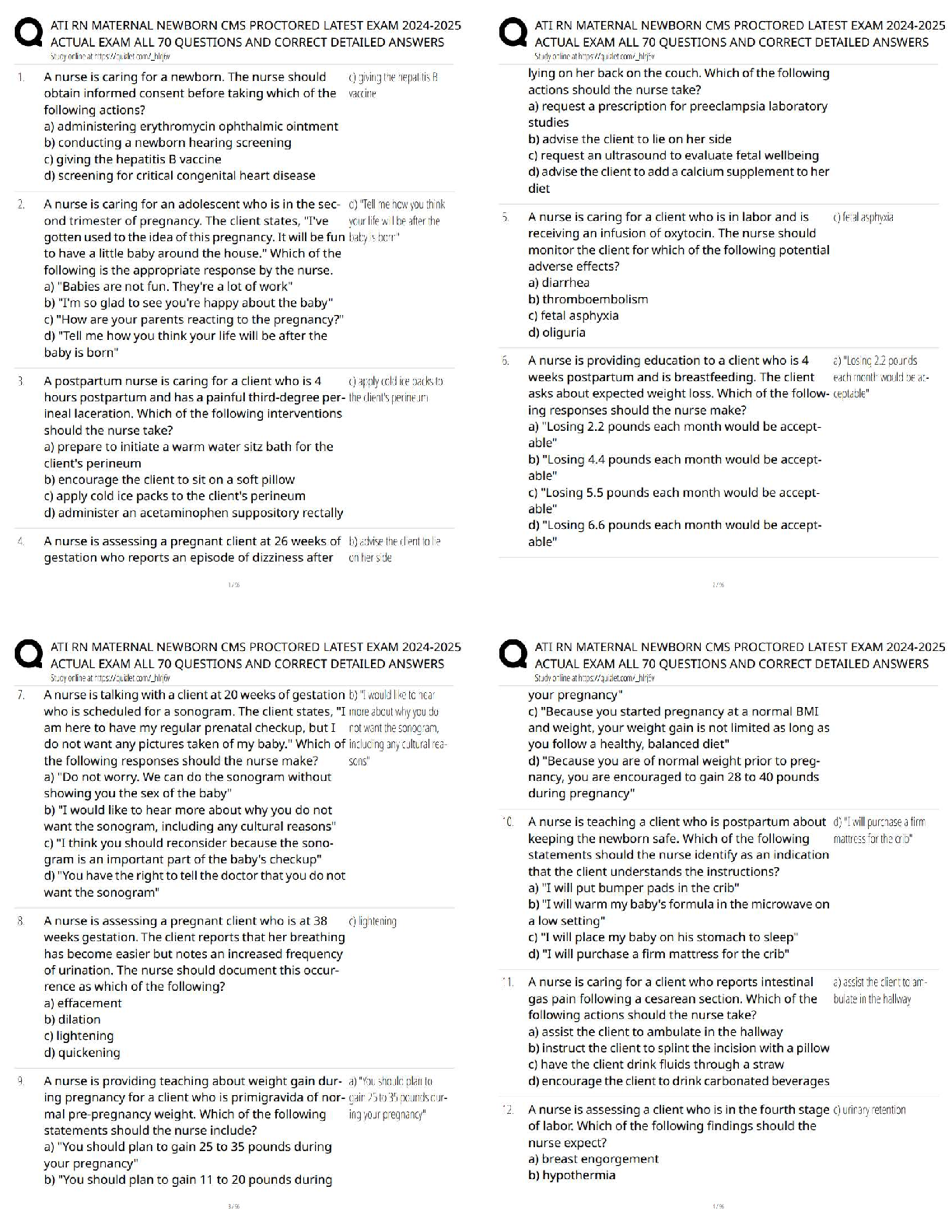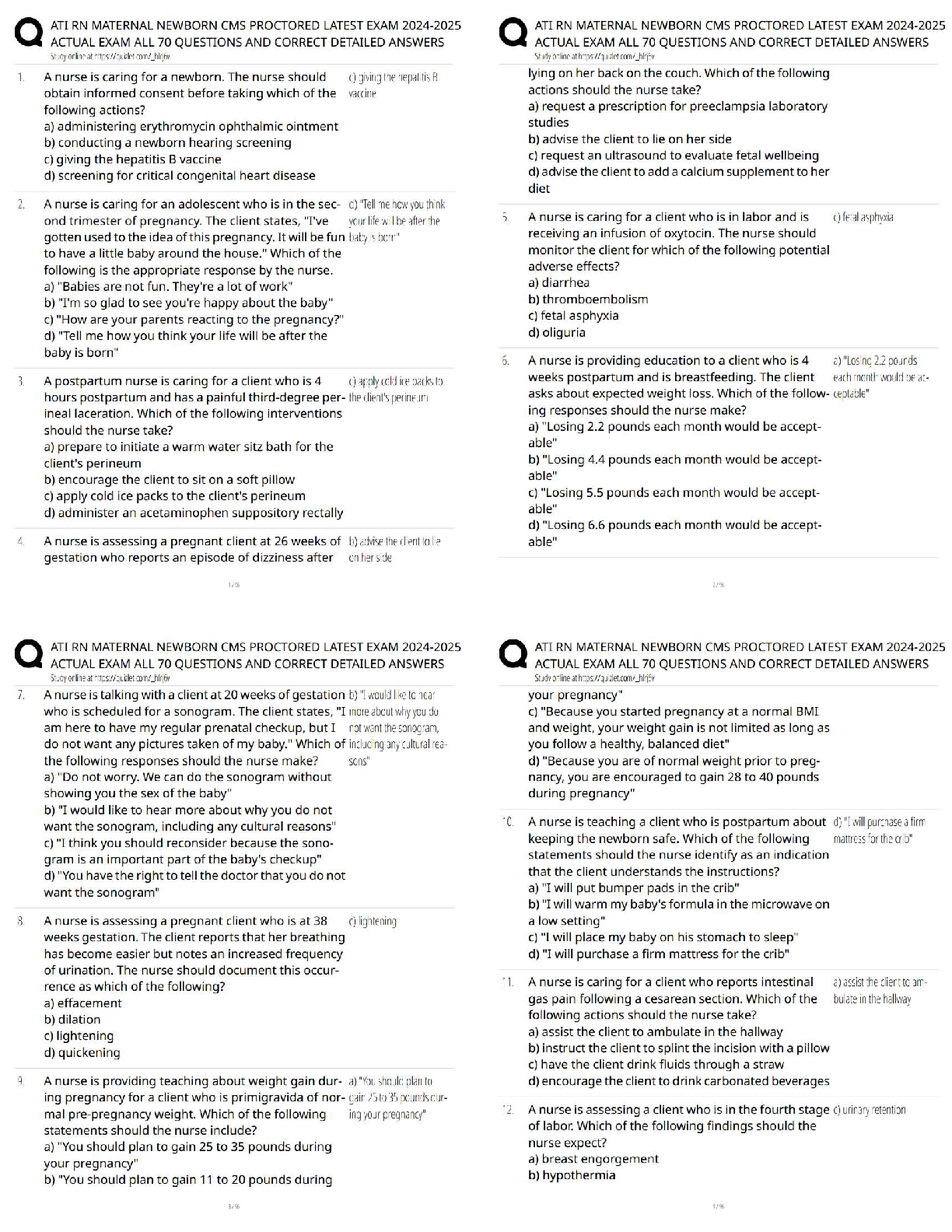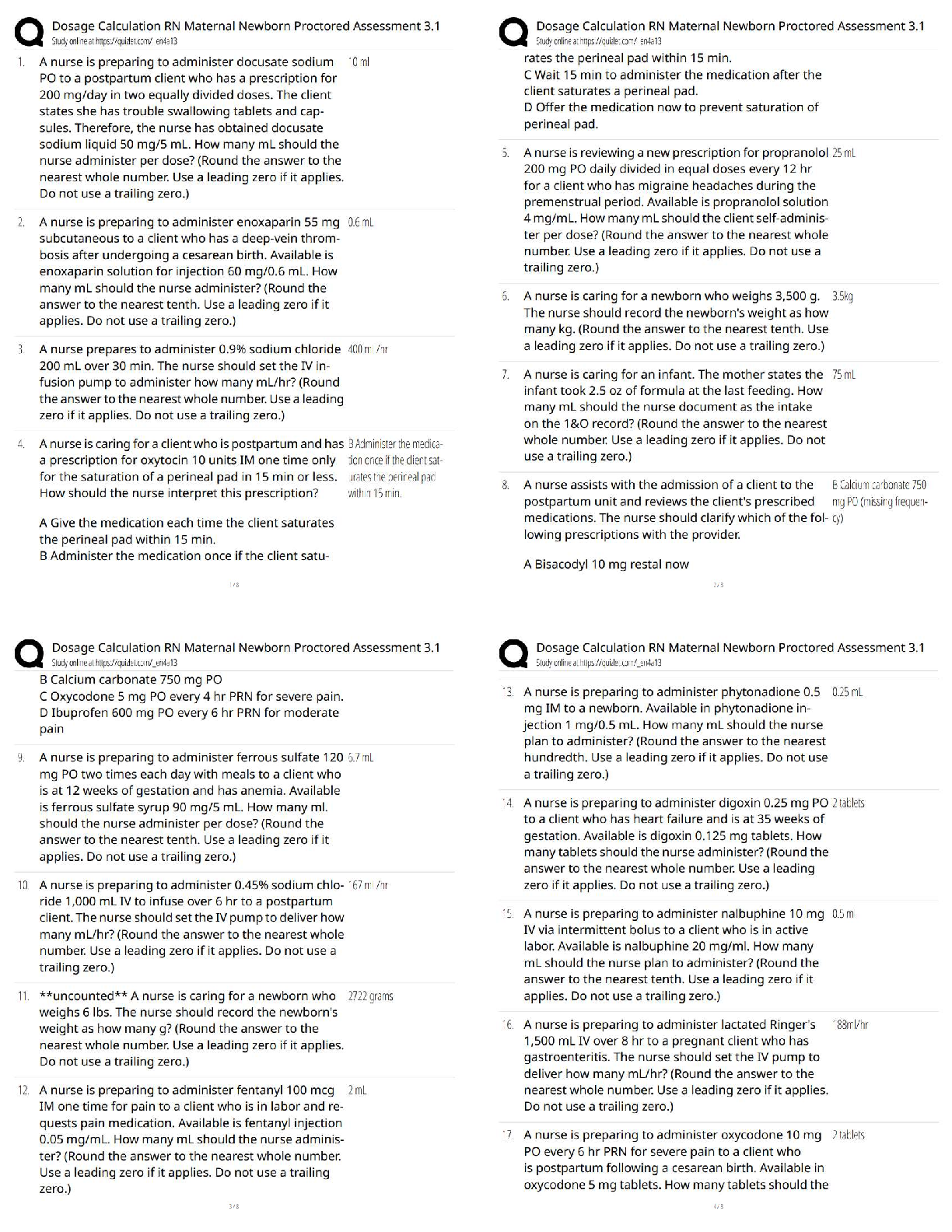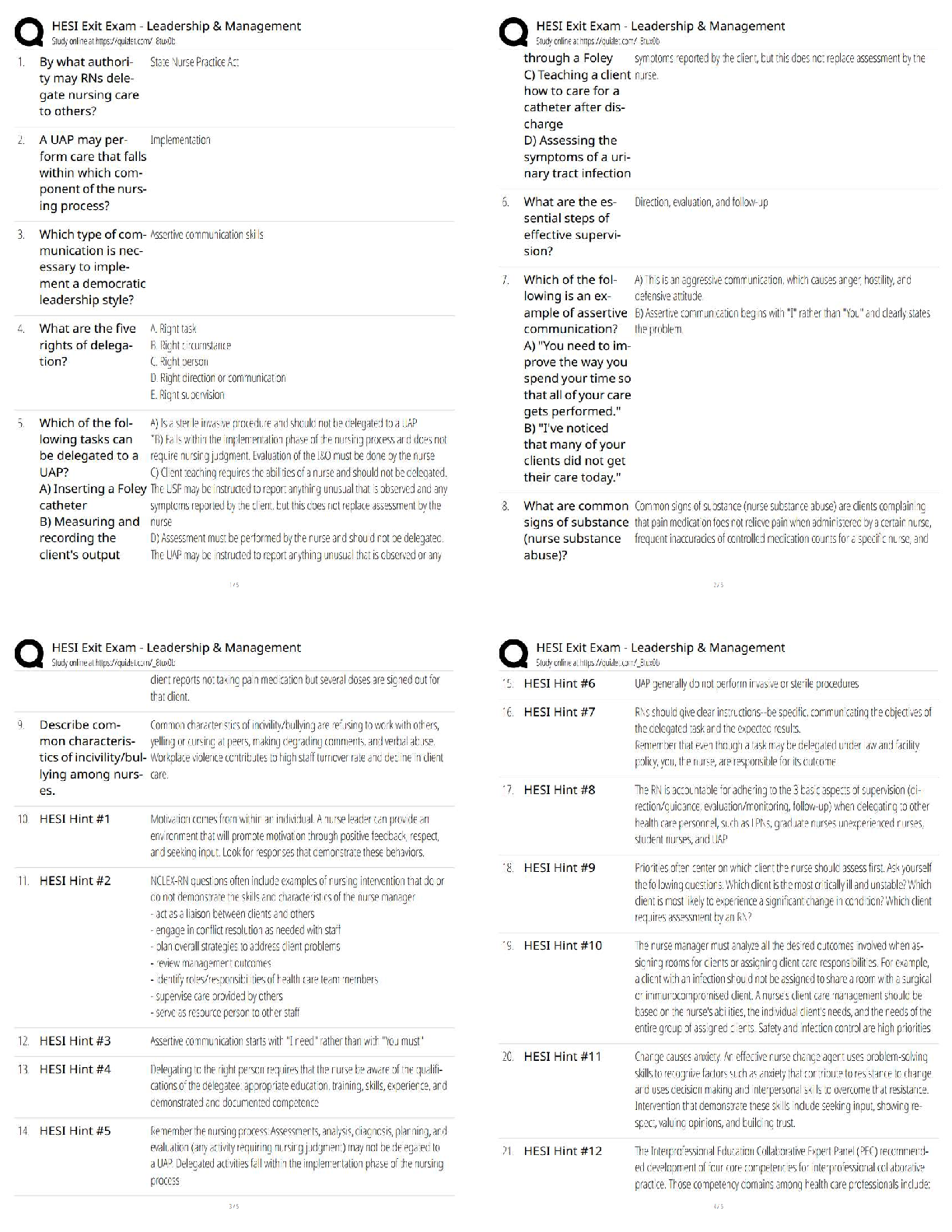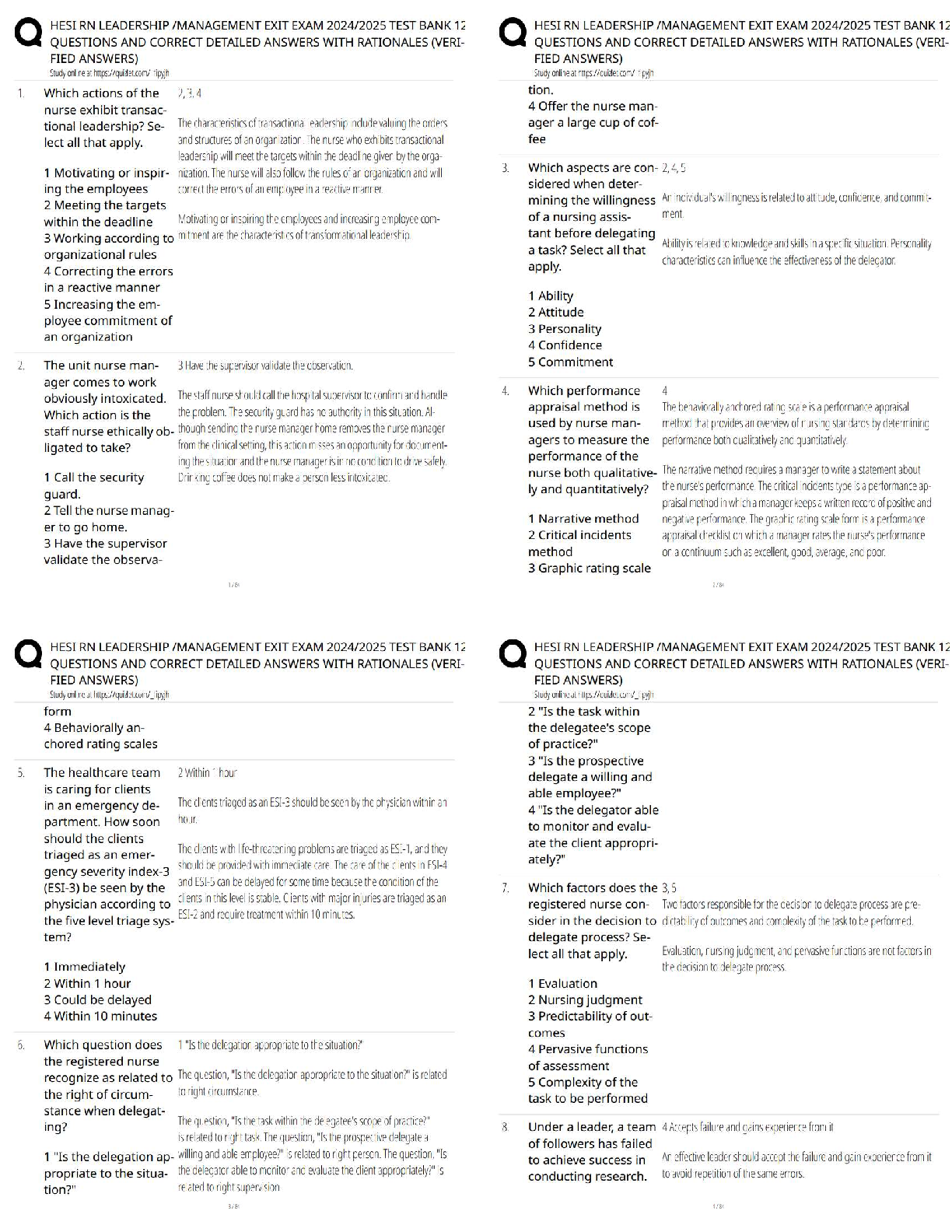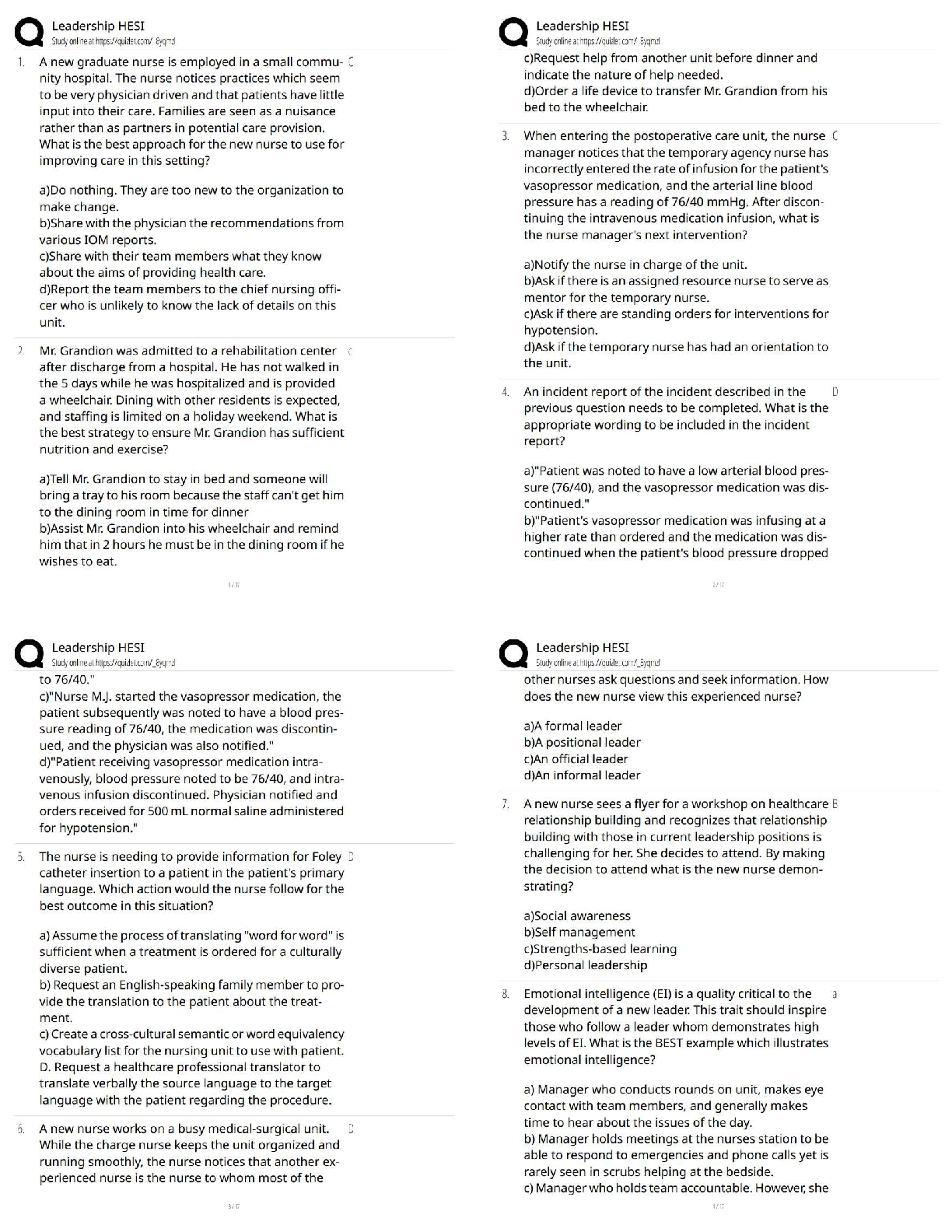*NURSING > QUESTIONS & ANSWERS > ASWB Exam 2019 Practice Test (51-100). Questions and answers. 100% predictor quizzes. (All)
ASWB Exam 2019 Practice Test (51-100). Questions and answers. 100% predictor quizzes.
Document Content and Description Below
A client in her mid-20s tells a social worker that she feels like a failure. She does not have a boyfriend, has been unable to find a full-time job after graduating from college, and is living at home ... . During the assessment process, the social worker praises the client for facing her problems and asks her about her accomplishments and positive skills, rather than her deficits. The social worker's actions are rooted in a(n): A. Functionalist approach B. Ecological perspective C. Resiliency model of treatment D. Strengths-based approach - ☑☑D A strengths-based approach is based on the assumption that a client has the ability to grow, change, and adapt, recognizing that there is always hope for change. A social worker with this focus looks at the skills that a client possesses, rather than his or her deficits. A social worker sees "the glass half full rather than half empty." He or she analyzes how a client's situation can be improved by capitalizing on the abilities that a client possesses, rather than focusing on the barriers that impede progress. The questioning of the social worker is a method to acknowledge one of the strengths of the client—help-seeking—despite the client's focus on problems. Which of the following is NOT an advantage of using an existing scale or instrument in the evaluation of social work practice? A. They have undergone reliability and validity testing. B. There are usually time and cost saving because they have already been developed. C. They are readily available for use. D. They have often been tested on a unique cultural group - ☑☑D There are advantages to using existing scales and instruments to evaluate practice. They are readily available for use (C). There are also considerable time and financial costs associated with developing new scales and instruments. Thus, using existing ones can be more efficient and less costly (B). In addition, existing scales and instruments may have undergone extensive testing, increasing their reliability and validity (A). One major disadvantage is that existing scales and instruments may not have been tested cross-culturally in order to determine their appropriateness, reliability, and validity with diverse populations (D). The service needs of a client should be primarily based on all of the following EXCEPT: A. Client's desires and motivations B. Results of the assessment process C. Prioritization of the client's basic and safety needs D. All services are available at the social worker's agency - ☑☑D The selection and prioritization of service needs may be driven by many factors including client desires and motivation (A) and the results of the assessment process (B). Social workers should consider Maslow's hierarchy of needs when working with clients (C), prioritizing those related to addressing basic and safety needs. Social workers should not limit recommendations to services that are familiar or provided by their employing agencies (D)—this would be a "cookie-cutter" or "one-size-fits-all" approach. A client is telling a social worker about her childhood. when asked about her relationship with her siblings, the client does not say anything for a long period of time. In this situation, the social worker should: A. Remain silent to allow the client time to reflect on the question B. Ask a question on another topic because it is obvious that the client does not want to discuss her sibling relationships C. Probe the client about the reason for the silence D. State that many children have problems with their sibilings and urge the client to express any issues that existed - ☑☑C Communication can be verbal and nonverbal. Silence is a form of communication and should be considered by a social worker when used by a client. The social worker should not change the topic (B) or assume that the silence is reflective of problems with her siblings (D). Although silence by a social worker can be an effective way to show acceptance of feelings (A), the social worker in this case vignette should probe for the reason for the silence (C) as a way of facilitating communication on issues related to the question. Which of the following is TRUE about the interplay of biological, psychological, social, and spiritual functioning of clients throughout their life course? A. Changes in physical abilities will likely impact on psychological, social, and spiritual functioning that will need to be addressed in order to assist clients effectively. B. Changes in physical functioning must be addressed before other life domains in order to ensure maximum independence. C. Spiritual functioning is constant and not influenced by biological, psychological, or social changes throughout the life course D. There is a strong relationship between these areas of functioning between these areas of functioning during childhood and early adulthood, but the strength of these relationships gradually decreases thereafter. - ☑☑A Human development is the product of the interplay of biological, psychological, social, and spiritual functioning. Systems theory indicates that a change to any one area of a client's life will influence all others. Social workers must be aware of the relationships that exist between the life domains in order to provide effective services and meet a client's needs. A young man comes to see a social worker because he feels "lost" and would like the social worker to help with his problems. In order to best assist the client, the social worker should: A. Ask the client what he would like to see changed in his life B. Give the client some suggestions for addressing his problems C. Refer the client for an evaluation for depression D. Praise the client for coming to seek help - ☑☑A Social workers focus on assisting clients to identify problems and areas of strength, as well as in increasing problem-solving strategies. It is essential that throughout the problem-solving process, social workers view clients as experts in their lives. Clients should be asked about what they would like to see changed in their lives and clients' definitions of problems should be accepted. The social worker in this case vignette should not provide suggestions because the ideas must be generated from the client. There is no indication that the client is depressed. Although praising the client for coming to see the social worker is appropriate, it does not "assist the client" directly. Which of the following is NOT true about age of majority? A.It is the age at which a client is recognized by law to be capable of managing his or her own affairs. B.It dictates when a client is legally responsible for his or her own actions. C.It is the same for every activity in every state. D.It usually indicates when parental legal responsibilities end. - ☑☑C The age of majority is when a client is recognized by law to be an adult, capable of managing his or her own affairs (A) and responsible for any legal obligations created by his or her actions (B). A person who has reached the age of majority is bound by any contracts, deeds, or legal relationships, such as marriage, which he or she undertakes. Parental obligations typically end when a child reaches the age of majority (D). In most states the age of majority is 18, but it may vary depending upon the nature of the activity in which the person is engaged. In a state, the age of majority for driving may be 16 while that for drinking alcoholic beverages is 21. Thus, it is NOT the same for every activity in every state (C). What type of power is obtained by associating with others who have power? A.Coercive B.Legitimate C.Reward D.Referent - ☑☑D Referent power is gained through charisma or associating with others who have power. Coercive power is obtained through control of punishment. Legitimate power comes from having legitimate authority. Reward power is obtained through control of rewards. Which of the following is the MOST current Diagnostic and Statistical Manual of Mental Disorders used by social workers? A.DSM-IV-TR B.DSM-IV C.DSM-6 D.DSM-5 - ☑☑D The DSM-5 was published in 2013 and is the current diagnostic framework used by social workers. It has many revisions in content and format from the DSM-IV-TR, which was used previously. A social worker is collecting information on dynamic risk factors when completing an assessment on a perpetrator of abuse. Which of the following characteristics will NOT be asked about in the interview? A.Current substance use B.Past history of violent behavior C.Access to weapons D.Living situation - ☑☑B Dynamic risk factors can be improved by interventions such as change in living situation, treatment of psychiatric symptoms, abstaining from drug and alcohol use, access to weapons, and so on. Static risk factors cannot be altered (such as past offenses, history of violence, age) and, thus, should not be the target of interventions. The Personal Responsibility and Work Opportunity Reconciliation Act (PRWORA) created the Temporary Assistance for Needy Families (TANF) program. Which of the following was NOT one of the restructured elements of this program? A.A lifetime limit on the number of years that benefits could be paid out of federal funds was imposed. B.Strict work requirements to qualify for federal aid were mandated. C.States could set their own benefit levels. D.A block grant to the states, which removed much of the federal regulatory authority over the design of the program, replaced a matching grant. - ☑☑C States were allowed to set their own benefit requirements under the Aid to Families with Dependent Children (AFDC) program, TANF's predecessor, which was created in 1935 as part of the Social Security Act. There were more restructured elements in TANF than those listed in A, B, and D. When helping a supervisee to use empathic communication when interacting with clients, a social worker is MOST effective by: A.Engaging in role playing with the supervisee to provide feedback on verbal and nonverbal communication skills used B.Explaining to the supervisee why clients need social work services C.Helping the supervisee understand how service delivery is perceived from clients' perspectives D.Suggesting the supervisee keep a journal to record feelings that interfere with therapeutic alliances when working with clients - ☑☑A Empathy is conveyed through both verbal and nonverbal communication. Thus, the MOST effective technique for assisting a supervisee is one that can assess communication in both areas. Role playing allows the social worker to see if there is congruence between the supervisee's nonverbal actions and verbal messages. It also will allow the supervisee to practice empathic communication skills before having to use them with clients. When a social worker is referred a client who is a different race or ethnicity from his or her own, the social worker should: A.Ask the client if he or she is comfortable working with the social worker given these differences B.Seek supervision and consultation to learn more about the client's race or ethnicity C.Acknowledge and recognize how the racial or ethnic differences between the social worker and client may impact on stages in the problem-solving process D.Refer the client to a social work colleague who shares the client's race or ethnicity - ☑☑C The most important factor impacting on the effective treatment of clients from different racial or ethnic backgrounds is self-awareness about how these differences can impact on the problem-solving process. While ascertaining the comfort level of the client may be important, as is seeking supervision and consultation, they are not as essential as acknowledging and recognizing the impact of these differences so that they can be considered in service delivery. A social worker should never make the decision for a client that he or she would be better served by a social work colleague of the same racial or ethnic background. There are more intragroup differences than intergroup differences among races and ethnicities. Thus, a social worker should not assume that the racial or ethnic differences between him or her and a client will be problematic. A client is having trouble at her job as her boss is asking her to do tasks that she does not feel qualified to do. The client has been afraid to say anything to her boss as she is worried about being fired. The BEST way for a social worker to help this client is to: A.Assist her with conducting a job search to locate other employment that is better suited to her qualifications B.Help her identify resources to enhance her skills in areas in which she does not feel qualified C.Explore with her why she feels inadequate to perform the requested tasks D.Engage in role playing with her to enhance her assertiveness skills - ☑☑D Role playing is a good way to assess and enhance clients' communication skills. Engaging in an active learning technique, such as role playing, will allow the client to practice asserting herself in a "safe" environment before doing so with her boss. This response choice is also BEST because it aims to enhance a skill that will be beneficial to the client not only in this situation, but in others in her life. The problem is not that the client is not qualified or does not feel qualified, but instead that she is reluctant to engage in a needed conversation with her supervisor. Which of the following communication styles is characterized by using criticism, blaming others, and having a low tolerance for frustration? A.Assertive B.Aggressive C.Passive D.Passive-aggressive - ☑☑B Clients and others who use aggressive communication styles display a low tolerance for frustration, use humiliation, interrupt frequently, and use criticism or blame to attack others. They are usually not good listeners and may act in a condescending or superior manner. Other communication styles include passive (avoiding expression of opinions/feelings, apologetic), passive-aggressive (acting passive, but sabotaging "behind-the-scenes"), and assertive (stating opinions/feelings and firmly advocating for position). A client is reporting feeling very tired and having trouble getting out of bed. He has recently experienced a lot of stress at work. In order to best serve the client, a social worker should FIRST: A.Refer the client to a health care professional to rule out any medical causes for the lethargy B.Determine if the source of the stress could be coming from other changes in the client's life C.Begin teaching him techniques to deal with stress [Show More]
Last updated: 3 years ago
Preview 1 out of 29 pages

Buy this document to get the full access instantly
Instant Download Access after purchase
Buy NowInstant download
We Accept:

Also available in bundle (1)
Click Below to Access Bundle(s)

ASWB EXAMS bundle,
Questions with accurate answers. Predictor questions and answers
By bundleHub Solution guider 3 years ago
$40
12
Reviews( 0 )
$10.00
Can't find what you want? Try our AI powered Search
Document information
Connected school, study & course
About the document
Uploaded On
Aug 15, 2022
Number of pages
29
Written in
All
Seller

Reviews Received
Additional information
This document has been written for:
Uploaded
Aug 15, 2022
Downloads
0
Views
130













